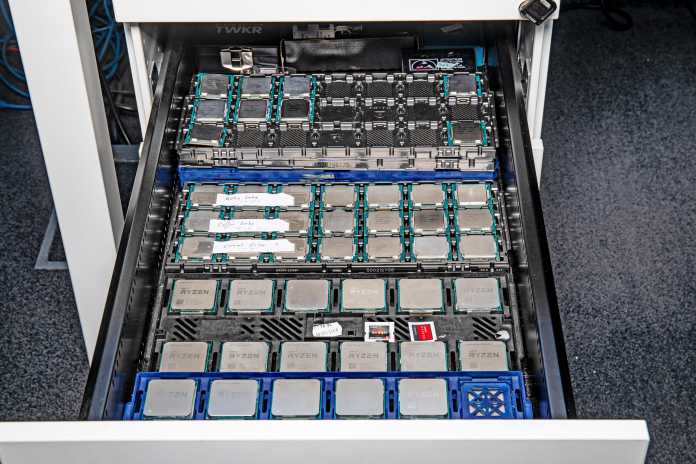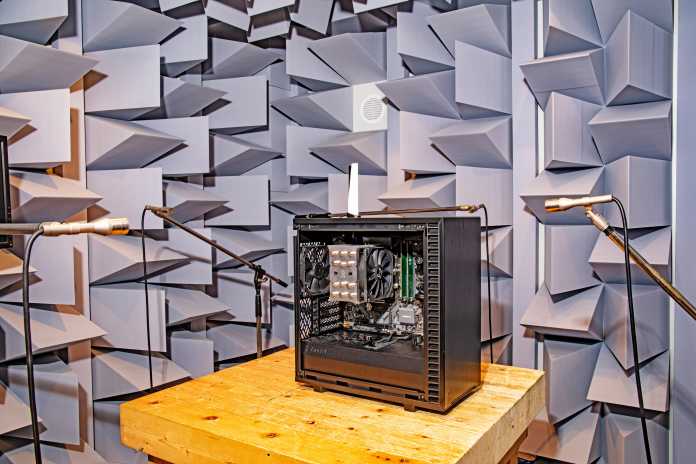- c’t tests would not be possible without technical assistants and extensive measurement equipment.
- With a desktop PC, we record up to a thousand measured values and parameters.
- Reproducible WLAN measurements only work in the basement, shielded by thick reinforced concrete walls.
A colleague once put it in a nutshell: “If the readers knew how much effort is behind a single number in our test table.” Until a finished test article appears in the printed magazine, not only the author has a lot of work to do. Because we don’t carry out most of the hardware tests alone, they are created in teamwork with the technical assistants.
They take a large number of measurements from us for each c’t issue. This not only relieves the editors so that they can concentrate on research and writing the article. It also has the advantage that these specialists, some with decades of experience, deliver reliable results even with tight production deadlines and bitchy test devices.

You can never have enough processors: We have several generations of AMD and Intel CPUs available for comparison benchmarks, building suggestions and component tests.
This explains why, apart from a few exceptions, we measure in-house and have staff and extensive measuring equipment ready for this. If there are problems or ambiguities, they can be clarified in a personal conversation and retested if necessary. In addition, the short distances save a lot of time.
Teamwork
For our tests, we measure numerous objective criteria such as power consumption, operating noise, interface speeds, audio and display quality and, of course, performance in various scenarios. In addition, we also give our subjective assessment. This allows you to avoid bad purchases and find the right product for your individual application more easily. Because the requirements are so different, we have dispensed with overall grades from the very beginning.
We show our test procedure using a complete PC as an example. The basic procedure hardly differs from other device categories. However, the editors work independently and focus on different aspects, for example to go into more detail about the special features of the respective product.

In the noise measurement booth, the building proposals for the ideal PC also have to prove how quiet they are. Four microphones eavesdrop on the computer all around.
Most tests require preparatory work, because only a few devices arrive suddenly and automatically in the editorial office. Sometimes it’s about brand new products, sometimes it’s about a coordinated and representative selection of similar devices, sometimes it’s about tips from readers or colleagues. In any case, test devices must be selected, ordered or requested as test samples.
After the computer has arrived in our editorial office, the office assistant enters it in our production database and gives it a unique test device number. The editor responsible receives an automatic e-mail notification that the long-awaited hardware is ready for collection in the central office. In addition, measurement results and product photos can be better assigned using the number than with often cumbersome product designations.
table work
We record the technical data, measured values, default settings and the scope of delivery in large measurement tables. In the hardware department, we use a template that has grown organically over 20 years for processors, mainboards and complete PCs as well as our construction proposals, which we regularly update, revise and purify. Today nobody is interested in the number of floppy ports and the throughput of FireWire, but faster and faster USB dialects are being added.
The table is on a local server. Thanks to LibreOffice’s file sharing, multiple editors and assistants can fill them out at the same time. We start each test with a blank template, because otherwise we would quickly lose track. Because we record around 1000 measured values and properties for each tested PC. This includes BIOS defaults, version numbers, hardware used, and processes that we document. The table also serves as a to-do list for us, and we work through the items one after the other.
The tables are archived by year and edition on the server. Last year, for example, we worked on an article about upgrading the c’t building proposal for the “Optimal PC” from 2017. Within a few minutes, we were not only able to use the table at the time to find the exact components used, but also use the BIOS settings and measured values to check whether everything was still working correctly.


